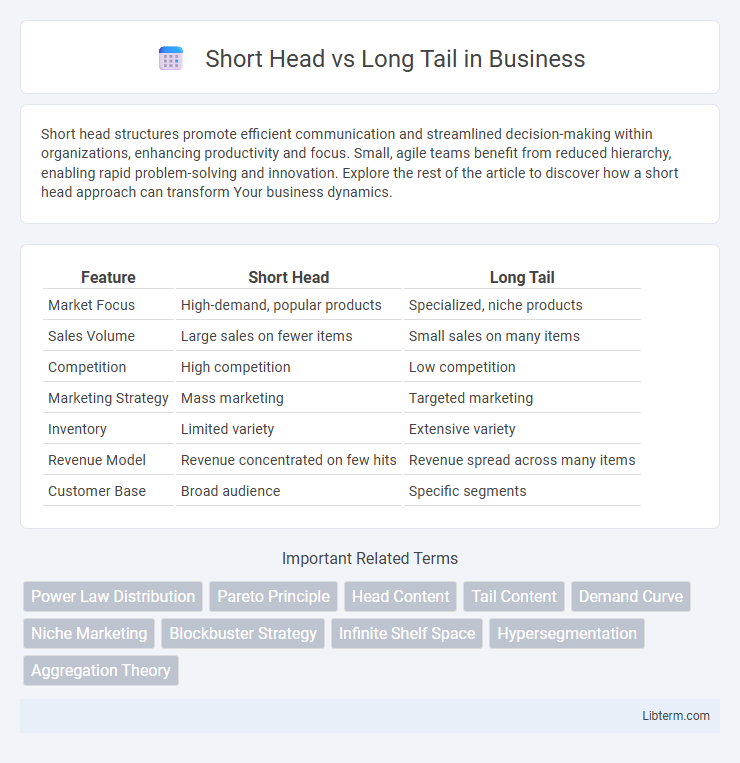Short head structures promote efficient communication and streamlined decision-making within organizations, enhancing productivity and focus. Small, agile teams benefit from reduced hierarchy, enabling rapid problem-solving and innovation. Explore the rest of the article to discover how a short head approach can transform Your business dynamics.
Table of Comparison
| Feature | Short Head | Long Tail |
|---|---|---|
| Market Focus | High-demand, popular products | Specialized, niche products |
| Sales Volume | Large sales on fewer items | Small sales on many items |
| Competition | High competition | Low competition |
| Marketing Strategy | Mass marketing | Targeted marketing |
| Inventory | Limited variety | Extensive variety |
| Revenue Model | Revenue concentrated on few hits | Revenue spread across many items |
| Customer Base | Broad audience | Specific segments |
Introduction to Short Head and Long Tail
Short Head refers to a small number of popular products or keywords that generate a large volume of traffic or sales, typically dominating market attention. Long Tail encompasses a vast number of niche products or less popular keywords that individually attract low volume but collectively make up a significant market share. This concept is crucial for understanding market strategies, content creation, and SEO optimization to balance mainstream appeal and niche targeting.
Defining the Short Head
The Short Head in marketing refers to a small number of high-demand keywords or products that generate the majority of traffic and sales. These items capture broad appeal and often dominate search results due to their widespread popularity. Focusing on the Short Head involves targeting competitive, high-volume terms that drive significant, immediate business growth.
Understanding the Long Tail Concept
The Long Tail concept emphasizes the value of niche markets by targeting a vast array of less popular products rather than relying solely on a few bestsellers from the Short Head. Online retailers like Amazon leverage the Long Tail by offering millions of unique items that collectively generate significant sales despite low individual demand. This model capitalizes on digital distribution and search technologies, enabling businesses to reach diverse customer preferences beyond mainstream hits.
Key Differences Between Short Head and Long Tail
Short Head keywords consist of high-volume, highly competitive search terms usually made up of one or two words, targeting broad audiences with significant traffic but lower conversion rates. Long Tail keywords are longer, more specific phrases that attract niche audiences, resulting in lower search volume but higher conversion rates due to their targeted nature. The key difference lies in search intent and competition, where Short Head keywords prioritize visibility and brand awareness, while Long Tail keywords focus on relevance and user intent for more qualified leads.
Advantages of Targeting the Short Head
Targeting the short head in marketing focuses on high-traffic, popular keywords that generate significant search volume and visibility, driving a large number of potential customers rapidly. This approach leverages well-known, competitive terms that can establish strong brand recognition and increase conversion rates due to their broad appeal. High search volume keywords in the short head also tend to have better data availability for analytics and optimization, enabling more effective decision-making in advertising strategies.
Benefits of Embracing the Long Tail
Embracing the Long Tail strategy allows businesses to tap into niche markets with lower competition, increasing overall market reach and customer diversity. By offering a wide variety of specialized products or content, companies can achieve steady revenue streams from multiple small sales, reducing reliance on a few blockbuster hits. This approach enhances customer satisfaction by catering to unique interests and drives sustainable growth through cumulative demand.
Short Head vs Long Tail in Digital Marketing
Short Head keywords in digital marketing represent high-traffic, competitive terms with broad search intent, generating significant visibility but often higher costs per click and lower conversion rates. Long Tail keywords consist of more specific, lower-traffic phrases that attract targeted audiences, improving conversion rates and reducing paid advertising expenses. Prioritizing Long Tail strategies enhances content relevance and engagement by addressing niche customer needs within digital campaigns.
SEO Strategies for Short Head and Long Tail Keywords
Short head keywords generate high search volume with broad competition, requiring SEO strategies that emphasize authoritative backlinks, high domain authority, and competitive content optimization to secure top rankings. Long tail keywords drive targeted traffic with lower search volume and less competition, enabling SEO strategies focused on niche content creation, user intent alignment, and conversational keyword integration to improve conversion rates. Balancing short head and long tail keyword strategies maximizes organic reach and niche audience engagement while enhancing overall SEO performance.
Case Studies: Successful Short Head and Long Tail Campaigns
Case studies demonstrate that short head campaigns, like Apple's centralized iPhone marketing, achieve massive brand visibility and rapid sales through broad targeting of popular keywords and demographics. In contrast, long tail campaigns such as Amazon's niche product listings leverage highly specific keywords to capture diverse customer segments, resulting in sustained traffic and higher conversion rates over time. Successful strategies combine short head for brand awareness and long tail for targeted engagement, maximizing overall campaign effectiveness.
Choosing the Right Approach for Your Business
Short head strategies target high-traffic, competitive keywords that drive immediate visibility and brand recognition, ideal for businesses seeking rapid growth and broad market presence. Long tail approaches focus on niche, specific search terms with lower competition and higher conversion rates, benefiting companies aiming for targeted audiences and sustainable customer engagement. Selecting the right approach depends on your business goals, market saturation, budget constraints, and the need for short-term impact versus long-term growth.
Short Head Infographic

 libterm.com
libterm.com